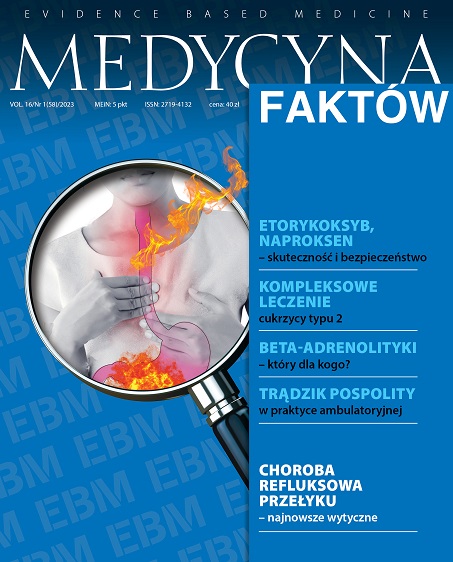Indywidualizacja drogi podania metotreksatu sposobem na optymalizację leczenia reumatoidalnego zapalenia stawów oraz łuszczycowego zapalenia stawów Artykuł przeglądowy
##plugins.themes.bootstrap3.article.main##
Abstrakt
Stosowanie metotreksatu w formie podskórnej powoduje, że występowanie objawów choroby jest relacjonowane w mniejszym stopniu (57,7% vs 72%), a działania niepożądane związane z przyjmowanym lekiem są zgłaszane rzadziej (25% vs 34%). Forma ta charakteryzuje się także wyższą skutecznością i bardziej elastycznym zakresem dawek. Z tych powodów może być ona zastosowana w przypadku nieskuteczności bądź nietolerancji leczenia formą doustną. Forma podskórna jest preferowana także u pacjentów z dużą aktywnością choroby (ze względu na szybkość działania i skuteczność) oraz u pacjentów z ŁZS z wielochorobowością i często współistniejącą chorobą stłuszczeniową wątroby (ze względu na lepszą tolerancję, mniejszą liczbę działań niepożądanych i dłuższy czas stosowania, co się przekłada na większą skuteczność).
##plugins.themes.bootstrap3.article.details##
Copyright © by Medical Education. All rights reserved.
Bibliografia
2. Gossec L, Baraliakos X, Kerschbaumer A et al. EULAR recommendations for the management of psoriatic arthritis with pharmacological therapies: 2019 update. Ann Rheum Dis. 2020; 79: 700-12.
3. Coates LC, Soriano ER, Corp N et al. Group for Research and Assessment of Psoriatic Arthritis (GRAPPA): updated treatment recommendations for psoriatic arthritis 2021. Nature Review. Rheumatology. 2022; 18: 465-79.
4. O’Dell JR, Cohen SB, Thorne JC et al. Treatment of rheumatoid arthritis in the USA: Premature use of tumor necrosis factor inhibition and underutilization of concomitant methotrexate. Open Access Rheumatol. 2018; 10: 96-101.
5. Choi HK, Hernan MA, Seeger JD et al. Methotrexate and mortality in patients with rheumatoid arthritis: A prospective study. Lancet. 2002; 359: 1173-7.
6. Ridker PM, Everett BM, Pradhan A et al. Low-Dose Methotrexate for the Prevention of Atherosclerotic Events. N Engl J Med. 2019; 380: 751-62.
7. Li L, Cui Y, Ying R et al. Medication adherence has an impact on disease activity in rheumatoid arthritis: a systematic review and meta-analysis. Patient Prefer Adherence. 2017; 11: 1343-56.
8. Barton A, Jani M, Bundy C et al. Translating research into clinical practice: quality improvement to halve non-adherence to methotrexate. Rheumatology. 2021; 60: 125-31.
9. Zhao R, Goldman ID. The proton-coupled folate transporter: physiological and pharmacological roles. Curr Opin Pharmacol. 2013; 13: 875-80.
10. Schiff MH, Jaffe JS, Freundich B. Head-to-head, randomized, crossover study of oral versus subcutaneous methotrexate in patients with rheumatoid arthritis: drug-exposure limitations of oral methotrexate at dose ≥ 15mg may be overcome with subcutaneous administration. Ann Rheum Dis. 2014; 73: 1549-51.
11. Artacho A, Isaac S, Nayak R et al. The pretreatment gut microbiome is associated with lack of response to methotrexate in new-onset rheumatoid arthritis. Arthritis Rheumatol. 2021; 73: 931-42.
12. Becker ML, van Haandel L, Gaedigk R et al. Analysis of intracellular methotrexate polyglutamates in patients with juvenile idiopathic arthritis: effect of route of administration on variability in intracellular methotrexate polyglutamate concentrations. Arthritis Rheuma. 2010; 62: 1803-12.
13. Stamp LK, Barclay ML, O’Donell JL et al. Effects of changing from oral to subcutaneous methotrexate on red blood cell methotrexate polyglutamate concentrations and disease activity in patients with rheumatoid arthritis. J Rheumatol. 2011; 38: 2540-7.
14. Bujor AM, Janjua S, LaValley MP et al. Comparison of oral versus parenteral methotrexate in the treatment of rheumatoid arthritis: A meta-analysis. PLoS ONE. 2019; 14(9): e0221823.
15. Ansari G, Nandagudi A, Bharadwaj A. AB0262 Clinical efficacy of switching from oral to subcutaneous methotrexate in management of rheumatoid arthritis: experience from out-patient setting of a district general hospital in UK. http://doi.org/10.1136/annrheumdis-2021-eukal.2212.
16. Braun J, Kastner P, Flaxenberg P et al. Comparison of the clinical efficacy and safety subcutaneous versus oral administration of methotrexate in patients with active rheumatoid arthritis: results of a six-month, multicenter, randomized, double-blind, controlled, phase IV trial. Arthritis Rheum. 2008; 58: 73-81.
17. Tanaka Y. Subcutaneous injection of methotrexate: Advantages in the treatment of rheumatoid arthritis. Mod Rheumatol. 2022; 00: 1-7.
18. Li CKH, Baker K, Jones T et al. Safety and tolerability of subcutaneous methotrexate in routine clinical practice. Arthritis Care Res (Hoboken). 2021; 73: 1306-11.
19. Generali E, Carrara G, Bortoluzzi A et al. Non-adherence and discontinuation rate for oral and parenteral methotrexate: A retrospective-cohort study in 8,952 patients with psoriatic arthritis. J Transl Autoimmun. 2021; 4: 100113.
20. Cairns R, Brown JA, Lynch AM et al. A decade of Australian methotrexate dosing errors. Med J Aust. 2016; 204: 384.
21. European Medicines Agency. Annex II, Scientific Conclusions. 2019 (access: 12.11.2022).
